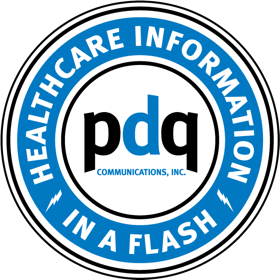Conveying a message that will resonate with healthcare professionals (HCPs) must include specific,...
Tracking the results of your healthcare marketing campaign is critical to ensuring its long-term success. Monitoring crucial performance metrics helps maximize reach and impact by identifying effective strategies as well as areas demanding improvements.
When measuring the progress of your HCP marketing campaigns, here are several key performance indicators (KPIs) you should be sure to track.
Email & Direct Mail Open Rates
Email and direct mail open rates are basic but essential KPIs to optimize your content strategy and identify the right message that resonates with your audience. Measuring your open rates provides better insights into the people you're targeting and what they respond to best.
It’s also effective to conduct A/B testing for your email campaigns, especially if your open rates aren’t where you’d like them to be.
Several factors can influence email open rates, including subject lines, sender credibility, email timing, and the relevance of the content, while direct mail open rates can be affected by the latter, design and packaging, and the perceived value of the information or offers inside. Personalization and segmentation positively impact open rates through tailored content that resonates with individual HCPs.
Comparing and modifying content, formats, subject lines, headers, graphics, send times, and other factors reveals important data about your campaigns and helps refine your strategy to pinpoint what works best.
Website Traffic & Engagement
Your website is the primary place prospects learn about your brand, products and services, and driving traffic to it is key to helping them along their buyer’s journey and converting them into loyal customers.
Tracking the amount of website visits you receive within a given period enables you to better allocate your time and resources to encouraging further engagement and conversions down the line. Follow your site’s analytics to see what features work and which need to change, from page design and content to navigation and general user experience enhancements.
In addition to website visits, keeping track of your audience’s level of engagement identifies their interests and aspects of your site content that are most effective at leading healthcare providers through the buyer’s journey. Measuring overall site engagement and specific content visits helps refine your content and offerings to make the best impressions possible.
Be sure to measure engagement across all of your channels. Take note of how many people click on links from email or paid advertisements or engage with your site after receiving direct mail content. This gives you a better idea of what your audience responds to and doesn't, and how you can better cater your message to entice your ideal healthcare providers.
Customer Acquisition Cost
Customer acquisition cost (CAC) plays a critical role in evaluating your healthcare marketing success, offering valuable insights into the expenses associated with acquiring new healthcare providers, as well as information about the overall effectiveness of your marketing efforts.
This represents the total cost linked to acquiring a new HCP customer—encompassing various expenses such as marketing and advertising costs, salaries, and technology tools used for marketing and sales.
Choose a specific time frame for your calculation, such as quarterly or annually, and add up all costs related to acquiring HCP customers within that period. This should encompass both marketing and sales expenses, and the number of new HCP customers.
Calculate it using the formula: CAC = Total Acquisition Costs / Number of New HCP Customers Acquired.
A higher number compared to the revenue generated from acquired HCP customers may imply inefficiencies in your marketing strategy, or a need for refining your targeting and messaging.
While a lower CAC is typically a positive indicator, suggesting that you are acquiring new HCP customers at a lower cost, it's also crucial to consider other factors, such as customer lifetime value, to assess the long-term sustainability of your acquisition efforts.
Customer Lifetime Value
Customer lifetime value (CLV) provides a deeper understanding of the value of your HCPs to evaluate the long-term revenue potential derived from customer engagement. CLV is a financial metric that quantifies the anticipated revenue an HCP is expected to generate during their entire association with your organization.
This can be especially important for the long sales cycles notorious within the healthcare industry, and encompasses both the initial acquisition cost and revenue generated throughout their engagement.
CLV informs your targeting and segmentation strategy, as well as influencing how and where you should allocate marketing resources.
High-CLV customers are valuable assets to retain. Accordingly, investments in customer retention strategies, including ongoing engagement, personalized content, and exceptional service, can maximize their value.
Conversion Rates
These essential benchmarks detail what percentage of visitors to your website or landing page convert or take a significant step toward becoming a real customer. Measuring your conversion rates will help you gain a better understanding of where your prospects are at every level of the buyer’s journey, and what aspects of your messaging and nurture campaigns resonate most with your prospects.
Conversion rates provide a tangible measure of how effective your healthcare marketing campaigns are in moving prospects through the sales funnel. A higher conversion rate indicates that your campaigns are impactful and engaging to your audiences.
Recognizing what touchpoints to measure and how your audience progresses through the sales funnel reveals a lot about the overall success of your campaigns.
The most important conversion rates to measure at each touchpoint include:
- Website Visits & Open Rates to Link Clicks
- Link Clicks to Form Submissions
- Leads to Marketing Qualified Leads (MQL)
- MQLs to Sales Accepted Leads (SAL)
- SALs to Sales Qualified Leads (SQL)
- SQLs to Customers
Marketing Qualified Leads (MQLs)
MQLs are pivotal KPIs measuring the amount of prospective customers who followed through on a call to action or completed a form to receive content. This signals that they’re not only interested in your brand, but actively want to engage and learn more about your content or offering, and are ready to become part of your nurture campaigns.
This helps you understand what offerings appeal most to your audience, and how to better curate your content to advance them through the buyer’s journey and convert them to customers.
Return on Investment (ROI)
Last but not least, your return on investment (ROI) is one of the most important metrics into how successful your overall strategy is based on how much you’ve spent.
Sales cycles for the B2B healthcare industry generally require more time and money than most other industries. In fact, the average projected cost of healthcare leads last year was $162—the second highest rate of any industry, according to web design and marketing firm Linchpin SEO.
With sales cycles typically spanning months or even years among healthcare providers, maximizing your ROI is essential to ensuring you aren’t wasting time or money on ineffective marketing tactics.
Calculate your ROI by measuring the time and resources invested in content creation, conversion rates, and sales revenue KPIs to understand the associated cost and sales revenue per lead and how long it takes for leads to convert to customers.
There’s no standard set of benchmark KPIs that apply to the entire HCP marketing industry. Different brands set their own unique goals according to their specific strategy and campaign objectives.
Be sure to conduct a full audit of your audience, analytics and meaningful KPIs regularly, and examine how to improve your campaigns to reach the greatest number of relevant HCPs for your needs.
Partner With PDQ Communications to Monitor Your Campaign’s Progress
Keeping track of numerous data points and analytics across all of your channels is a necessary but daunting and time-consuming task. Working with PDQ Communications helps you develop and maintain your strategy to expand your reach and produce quality content that resonates with your intended audience.
If you're ready to take your HCP marketing strategy to the next level, contact PDQ Communications today and learn more about what we can do for you.








